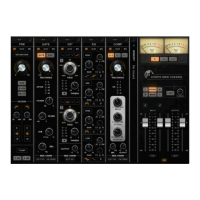Scheps Omni Channel / User Guide
Example #3: Overheads
• Dealing with overheads can be tricky and every recording is different. But let’s assume this is a relatively
straight-ahead recording acting as cymbal mics, as opposed to trying to capture a complete, full-frequency
picture of the drum kit.
• The first thing to do might be to put a 12-dB-per-octave HP filter on both sides to take care of any sub from
the kick or toms.
• Next, let’s EQ in M/S mode. This will let you add a little low mid in the middle of the image to give body to the
kit. Then add some top shelf to the sides in order to open up the cymbals without stepping on the snare or
vocal. Then, in Expanded view, put one midrange band in parametric mode, link the controls, and find the
harsh area around 3 kHz using the Ctrl solo shortcut, and then suck some of it out to make things clearer.
• From here, make sure your Compressor is post EQ and start with the VCA compressor for some clean punch,
or maybe the FET compressor for some dirt. Really play with the attack and release times to get the
excitement that the compression can add without destroying the transients and dynamics.
• Also, don’t forget to try the compressor in Duo mode instead of Stereo mode. Unlinking the compressors
might make the drums feel wider.

